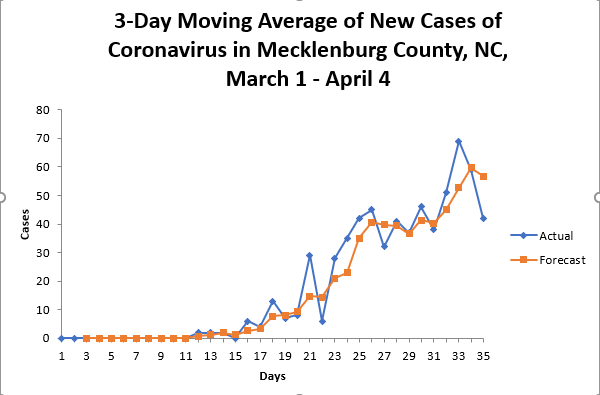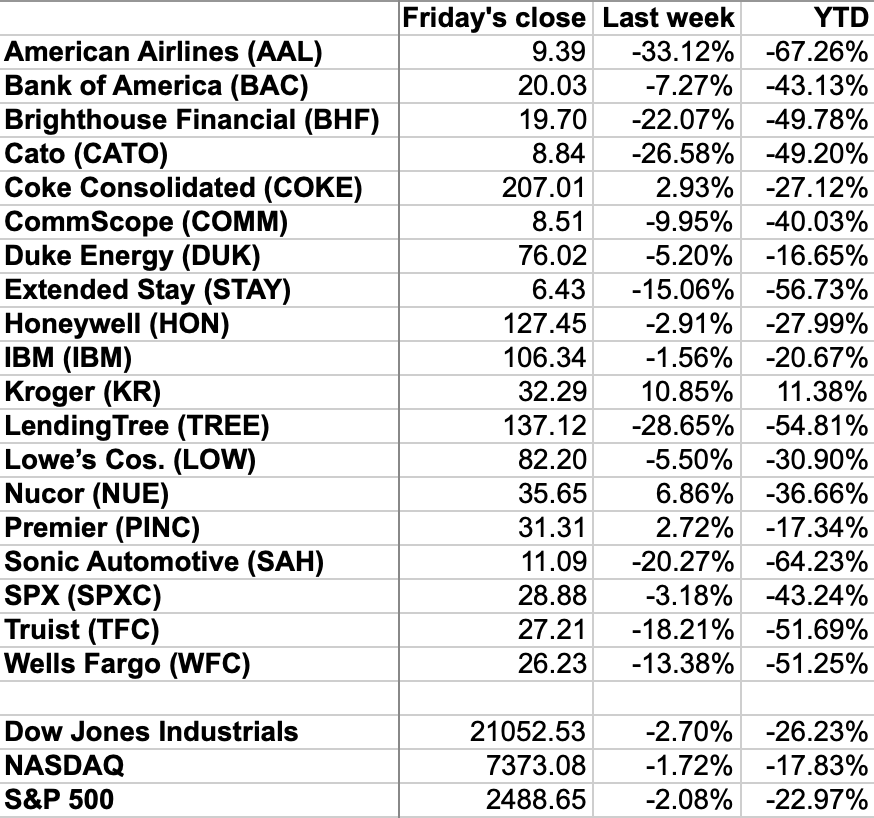Chaotic start to crucial loan program
Plus: How to understand coronavirus data; Closer look at massage parlor cited for 'stay at home' violation; Durham says breweries are non-essential
Local small businesses scramble to apply for coronavirus relief to stay afloat; ‘It’s just stressful as heck’

Many of Charlotte’s banks had to move quickly to accommodate the surge of interest in a new federal loan program for small businesses that started Friday. (Photo courtesy of Myles Gelbach)
Thousands of small-business owners in the Charlotte region have had a draining last few days trying to figure out a new government loan program that could be a vital lifeline for their struggling businesses.
The new federal initiative, part of the massive $2 trillion relief bill passed two weeks ago, is called the Paycheck Protection Program, or PPP. But it got off to a rough start on its first day on Friday: Not all banks were ready for the scramble to submit loan applications, and those that were — like Bank of America — faced criticism for not working with enough customers or for having a confusing application process.
The Ledger talked to six local small-business owners this weekend. While a few said their applications went off without a hitch, one called the roll-out a “disaster.” Another called it a “sh— show.” Most agreed the program is going to be rife with fraud.
Crucial support: The program is a huge deal for small businesses hurt from the effects of the coronavirus, because companies can qualify for loans equal to 2.5x their monthly payrolls — and the loans are forgiven if the companies meet certain qualifications, including keeping workers employed. If you know a local small business that has suffered in the last few weeks, odds are it has applied for the program, is trying to apply for the program or has considered it.
Businesses receiving money from the PPP could re-hire the workers they have recently laid off. The money is intended to last for up to eight weeks. Some companies said they were hopeful they might receive the money as soon as this week.
Rush for money: Many local businesses spent the last week reading up on the changing details and organizing their information to apply for a loan through their banks. But the program came together so quickly that banks didn’t really have time to build the infrastructure necessary to accommodate loan applications — even though many of those applying say they need the money right away.
“From the banks’ point of view, they don’t have the systems in place to deal with this, and all their clients are screaming at them, wanting to do it ASAP,” says Greg Brown, owner of Cardinal Finance, a Charlotte financial consulting company for small- and mid-sized firms. “… Who would have built systems to handle half of the businesses in America applying for a loan all at once? Answer: no one.”
None of the half-dozen local businesses interviewed this weekend by The Ledger wanted its name used publicly, for fear of alienating banks that were reviewing loan applications. But they all expressed some degree of frustration with the changing requirements of the program. It wasn’t always clear what kind of payroll data the government and banks wanted, for instance.
One business owner said the online application with her bank kept timing out after 15 minutes, before she could enter all the required information. “It’s just stressful as heck,” she said.
Another business owner worried she would be shut out of the program, with all the loan money being committed before she could apply. Bank of America last week initially said it would process requests only for existing business customers who had a loan, line of credit or a credit card — so if you had only a checking account, you were ineligible.
“I smell a rat here, and to take advantage for financial gain when people just want to make payroll to keep their businesses going? I’m sorry, it’s just wrong,” the business owner told The Ledger.
After an online backlash, Bank of America relented and said it would eventually consider customers who didn’t have those products.


The worry, though, is that the $349B the government has allocated to the program could quickly run out. Wells Fargo said Sunday night that it had already received $10B in customer interest, which “it expects will fill the company’s capacity to lend under the program.”
The rush to shovel money out the door could result in quick underwriting that doesn’t fully vet applicants. “The opportunity to defraud this program seems large,” one business owner said.
On Friday night, the head of the Small Business Administration said nearly 14,000 loans had been approved nationwide:


Making sense of the coronavirus data
When the Super Bowl is on, everybody becomes an armchair football coach. And when there’s a global pandemic, everyone is suddenly an epidemiologist, sifting through the numbers to divine their meaning.
To help understand the statistics that come out regularly from the state and county health departments, we figured we’d check in with an actual epidemiologist.
Ahmed Arif is an associate professor in UNC Charlotte’s Department of Public Health Sciences, and his research focus is occupational and environmental epidemiology, particularly respiratory illnesses. He shared his thoughts on what numbers we should and shouldn’t be keying on as we seek clues to the future of the coronavirus in Charlotte and in North Carolina. Remarks were edited for brevity and clarity:
Q. What is the best way to approach these numbers and try to make sense of the data we have?
There are two numbers that are usually looked at. One is the number of new cases that are happening, in Mecklenburg County and in North Carolina. The other is hospitalization. Hospitalization is more predictive of death.
I can find a lot of information on new cases, and it seems like it is increasing every day. It’s going to hit a threshold, and then it’s going to spike.
Q: When you say new cases, do you mean the total number of new cases per day?
Exactly. The number of cases, these are called incident cases. Incidence is the number of new cases that are occurring. If it is going up, that gives you some idea. If that number is going down, then you may have a good sense that social distancing is working.
We started social distancing only on March 25. It’s too early to say, honestly.
Q: What is an appropriate way for people to use the data, and what is an inappropriate way to use the data?
Most of the time you see presented this cumulative graph with the total number of cases. The total number of cases — they’re going to increase. The appropriate way to look at it is to see what is the increase? Is it increasing over time or not, every day?
And hospitalizations: Some of those cases, if they are pretty severe, then hospitalization is a very big concern. We really do not know how many cases there are that are not showing any symptoms. That’s a big issue.
Q: How do they do modeling? How is it possible they are saying we might need 3,000 more beds than we have capacity for when the number of cases right now is so relatively low?
Statistical models are based on some real numbers and some assumptions, a lot of assumptions. These models have a lot of assumptions in them. They’re assuming, what is the rate of growth? That’s the single most important factor: What is the rate of growth in infections in the community? If that growth is continuing to increase, maybe in two weeks it will peak. Once it peaks, that’s a lot of hospitalizations, which will overwhelm our health resources.
Q: How difficult is the job of predicting when the testing they are doing is so limited, when there’s not a lot of good data?
There is no way to know how many people might have it. You look at existing data from other places, and you make some assumptions. In other states, we know how rapidly it is spreading, what is the doubling time. It is a difficult job. It’s based on a lot of assumptions. Assumptions may be wrong, but they are the best tools we have now.
Q: Is it still too early to know how this will play out, or do we know it is going to be bad?
I think it’s both. If the numbers start to go down, if people start using common sense and maintaining some kind of social distancing, you may find a very different outcome.
It all depends. We do not have a cure. The only thing is prevention.

Ahmed Arif, an epidemiologist with UNC Charlotte’s Department of Public Health Sciences, created this graph showing the actual number of new confirmed coronavirus cases per day in Mecklenburg County, using data from the state. It shows the three-day moving average of new cases per day (orange) and the actual daily number of new cases (blue). Comparing the number of new confirmed cases with the number from previous days helps reveal trends about what will happen next with the coronavirus, Arif says.
Today’s supporting sponsors are T.R. Lawing Realty:

… and TechnikOne:

Not your average day spa
After Charlotte-Mecklenburg Police issued the first citation for violating the “stay at home” order, some folks on social media started looking a little more closely at the massage parlor that was cited.
What they found was that the Cool Cave Spa on Monroe Road, near the intersection with Sharon Amity Road, appears to be a different sort of place than you might find at, say, a spa at an upscale hotel like the Ritz-Carlton.
On its Instagram page, Cool Cave Spa advertises its “happy hour” specials and boasts of its “gorgeous NEW Asian, Latin and American staff” — often with photos of them in lingerie or with a come-hither look:
Their Instagram also features the occasional “new girl alert.” In a post on Facebook, the spa says that in addition to massages, it offers a “#sensual #bodyrub.”
Police cited the spa’s manager last week after repeated warnings that massage businesses are not allowed to operate under the county’s “stay at home” order. The spa’s owner said the business is not open but that people were inside organizing charitable activities.
On Sunday, the spa posted on its Instagram account a quote attributed to Donald Trump: “Good publicity is preferable to bad, but from a bottom-line perspective, bad publicity is sometimes better than no publicity at all. Controversy, in short, sells.”
In brief:
Low infection rate: Of the 50 states, North Carolina has the sixth-lowest number of confirmed coronavirus cases per capita, according to an analysis by the New York Times. The state’s rate of 20.6 confirmed cases per 100,000 residents is better than that of all states except Texas, Kentucky, Nebraska, Minnesota and West Virginia. New York, with 524 cases per 100,000 population was the worst, followed by New Jersey and Louisiana. (New York Times)
Durham breweries non-essential? A Durham brewery said it is halting curbside beer pickup after local health officials determined that the county’s “stay at home” order does not consider breweries and bottle shops to be essential businesses. In a Facebook post on Sunday, Barrel Culture Brewing said it was seeking clarity from local authorities. An FAQ on Durham’s website says “distilleries, breweries and bottle shops cannot continue curbside delivery. Similarly, they should not be manufacturing.”
‘Rainy day’ money unused: City and county leaders have $375M in cash reserves but haven’t tapped into the money to help alleviate economic pain associated with the coronavirus. Other local governments in the Charlotte region have started loan programs and have accelerated construction projects to help put people to work. (Observer)
Council meeting: The Charlotte City Council meets today to receive updates on Covid-19 responses, “stay at home” order enforcement, coronavirus relief and affordable housing. The meeting is at 5 p.m. and can be viewed on the Government Channel or the city’s Facebook page or YouTube channel.
Senior liquor shopping: Starting tomorrow, 10 Mecklenburg ABC stores will open an hour early for seniors on Tuesdays and Thursdays. Opening at 9 a.m. will “help them maybe feel a little safer coming in,” the local ABC commission’s CEO said. (WBTV/Observer)
Abortion protest arrests: Charlotte-Mecklenburg Police arrested eight protestors outside an abortion clinic on Saturday and charged them with violating the ban on mass gatherings. (Observer)
Google mobility report: Mecklenburg County residents are taking fewer trips to workplaces (-43%), transit stations (-70%), retail shops (-53%) and grocery stores (-23%), but they’re going more to parks (+1%), according to location data from Google.
Taking stock
Unless you are a day trader, checking your stocks daily is unhealthy. So how about weekly? How local stocks of note fared last week (through Friday’s close), and year to date:

Need to sign up for this e-newsletter? Here you go:
Got a news tip? Think we missed something? Drop me a line at editor@cltledger.com and let me know.
Like what we are doing? Feel free to forward this along and to tell a friend.
Archives available at https://charlotteledger.substack.com/archive.
On Twitter: @cltledger
Sponsorship information: email editor@cltledger.com.
The Charlotte Ledger is an e-newsletter and web site publishing timely, informative, and interesting local business news and analysis Mondays, Wednesdays, Fridays and Saturdays, except holidays and as noted. We strive for fairness and accuracy and will correct all known errors. The content reflects the independent editorial judgment of The Charlotte Ledger. Any advertising, paid marketing, or sponsored content will be clearly labeled.
Editor: Tony Mecia; Contributing editor: Tim Whitmire





